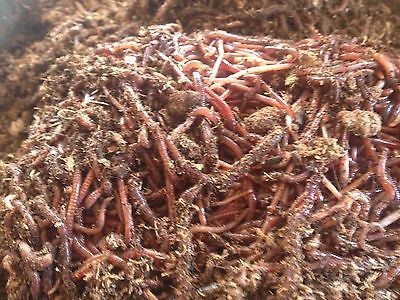Nutrient-rich red worms: Perfect for compost bins
Nutrient-rich red worms: Perfect for compost bins
Blog Article
Red Wigglers: The Secret to Eco-Friendly Composting
Red wigglers, medically understood as Eisenia fetida, play a critical duty in lasting composting methods, supplying a natural service to squander management. red wigglers. These worms not just eat natural products but additionally change them into beneficial vermicompost, enhancing soil health and wellness and promoting ecological balance.
What Are Red Wigglers?
Although many individuals recognize with earthworms, red wigglers (Eisenia fetida) are a specific types that play a crucial function in composting. Native to Europe, they have adjusted well to a range of atmospheres, specifically in decaying raw material. Unlike typical yard worms, red wigglers thrive in abundant, moist environments, making them ideal for composting systems.
(red wigglers for sale cheap)These worms are identified by their reddish-brown coloration and extended bodies, normally measuring in between 3 to 4 inches in length. Red wigglers are epigeic worms, implying they reside near the soil surface area and prey on decomposing natural material. Their high reproductive price allows populaces to expand rapidly under optimal problems, with the capability to increase in number every couple of months.
Red wigglers possess a distinct digestive system that enables them to damage down natural waste successfully. Their sustainable nature makes red wigglers an important asset in eco-friendly composting methods.
Advantages of Making Use Of Red Wigglers
Using red wigglers in composting systems provides numerous benefits that enhance both the performance of waste decomposition and the quality of the resulting compost. These earthworms, scientifically called Eisenia fetida, are renowned for their remarkable ability to take in organic waste, converting it right into nutrient-rich vermicompost at an outstanding price. Their fast digestion process increases the break down of cooking area scraps and yard waste, dramatically minimizing the moment needed for composting.
Along with their efficiency, red wigglers contribute to boosted soil framework and fertility. The vermicast created by red wigglers is abundant in crucial nutrients, helpful bacteria, and humic acids, all of which boost dirt health and wellness and promote plant development. This nutrient-dense compost helps keep wetness and improves aeration in the soil, fostering a growing ecosystem for plants.
Moreover, using red wigglers for composting minimizes garbage dump waste, adding to a much more lasting waste monitoring system. By diverting organic materials from garbage dumps, composting with red wigglers decreases greenhouse gas discharges, making it an environment-friendly selection for eco conscious individuals and communities. Overall, red wigglers provide a reliable and lasting option for composting.
Establishing Your Worm Bin
Developing a worm container is a straightforward procedure that needs mindful consideration of products and conditions to make certain a growing environment for red wigglers. Begin by choosing a proper container, which can be a plastic bin or wooden box, with a capacity of at the very least 10 gallons for efficient composting. Guarantee the bin has sufficient ventilation by drilling little holes in the cover and sides to allow air flow.
Following, prepare the bed linen, which is vital for keeping wetness and offering an environment for the worms. Ideal materials include shredded paper, cardboard, coconut coir, or peat moss. Go for a bed linen deepness of roughly 4-6 inches, ensuring it is moist yet not overly damp.
It is essential to maintain the best temperature for your click here for info worm bin, preferably between 55 ° F and 77 ° F(13 ° C and 25 ° C) Position the bin in a shaded location to prevent overheating. In addition, keep the container far from straight sunlight and severe weather to shield the worms.
Feeding Your Red Wigglers
Feeding your red wigglers is a critical facet of successful worm composting, as it straight affects their wellness and the effectiveness of your composting system. Red wigglers prosper on a healthy diet plan consisting largely of natural waste materials. Ideal food options include fruit and vegetable scraps, coffee grounds, smashed eggshells, and shredded paper. Stay clear of feeding them meat, dairy products, and oily foods, as these can draw in pests and produce odors.
(red worms)To guarantee ideal feeding, it is important to introduce food slowly. Beginning with percentages to permit the worms to take in the product totally before adding extra. This technique avoids overfeeding, which can result in anaerobic problems and adversely affect worm health and wellness. Monitor the food disintegration process and adjust the quantity based on just how promptly the worms are refining the waste.

Maintaining Your Worm Compost System
A properly maintained worm compost system is important for making best use of the performance and durability of your composting efforts. Normal surveillance of dampness levels is essential, as red wigglers thrive in a moist environment, preferably around 70% humidity. If the bed linen ends up being also dry, gently haze it with water; alternatively, if it comes to be overly damp, add completely dry bedding such as shredded newspaper or cardboard to absorb excess moisture.
Temperature control is likewise crucial. Ensure your compost system is maintained in a shaded, aerated area to avoid overheating.
In addition, check for any kind of undesirable odors, which may show an inequality in the system. Consistently freshening the garden compost by gently transforming it will assist preserve proper air flow and avoid anaerobic problems. Finally, keep an eye on the worm populace and their activity; a growing populace shows a healthy environment. By following these maintenance methods, you can make certain an effective and lasting worm composting system that successfully reuses natural waste.

Final Thought
In verdict, red wigglers play an essential role in environment-friendly composting by effectively transforming natural waste into valuable vermicompost. Their ability to flourish in rotting products not just aids in lowering garbage dump waste and greenhouse gas exhausts but also boosts soil health and wellness. By advertising wetness retention and oygenation, these worms add dramatically to sustainable gardening practices. Embracing the usage of red wigglers represents a useful approach to enhancing environmental sustainability and fostering healthier communities.
Report this page